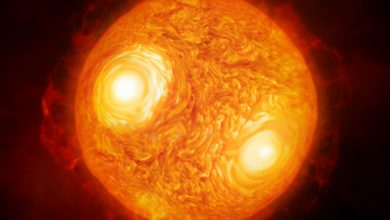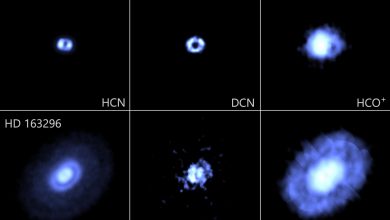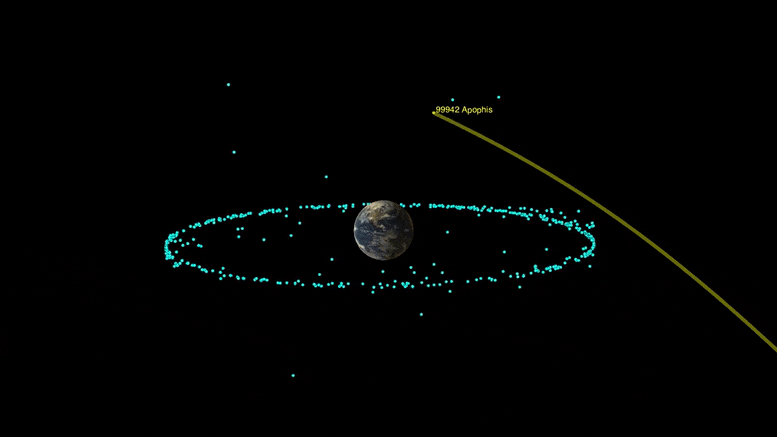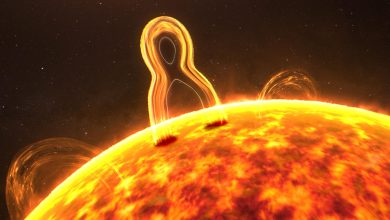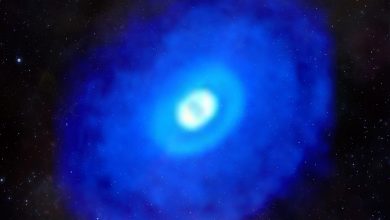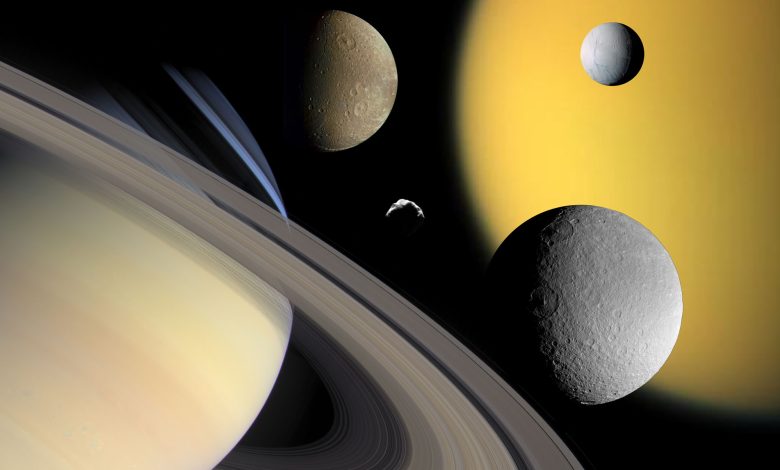
Today, we look at Saturn’s largest moons, which many consider to be the most likely place to find extraterrestrial life and a prime location for human settlement.
We know about this system from many decades of robotic explorers, the most recent of which was the Cassini-Huygens mission. Between 2004 and 2017, this mission studied Saturn, its ring system, and its moons extensively. What was especially interesting was what the mission revealed about two of Saturn’s moons – Titan and Enceladus.
Titan, Saturn’s largest moon, is the only body in the Solar System beyond Earth with a dense nitrogen-rich atmosphere. Its atmosphere and surface are rich in organic molecules and prebiotic chemistry, including methane and other hydrocarbons. It has even been speculated that there could be life on Titan that relies on methane the same way Earth organisms rely on water.
Then there’s Enceladus, known for its “Tiger Stripes” and plume activity around its southern polar region. These plumes are connected to an ocean located beneath the icy surface and are believed to result from hydrothermal activity at the core-mantle boundary. Titan and several more of Saturn’s moons fall into the category “Ocean Worlds,” where tidal flexing in their interiors leads to geothermal activity and interior oceans.
It’s little wonder why NASA and other space agencies are so eager to send missions to explore Saturn’s moons in the near future – missions like NASA’s Dragonfly rotorcraft, which will explore Titan’s atmosphere, surface, and lakes by the 2030s. There have even been proposals for creating permanent human outposts on Saturn’s moons that would take advantage of the low-radiation environment, abundant resources, and the immense potential for scientific research.
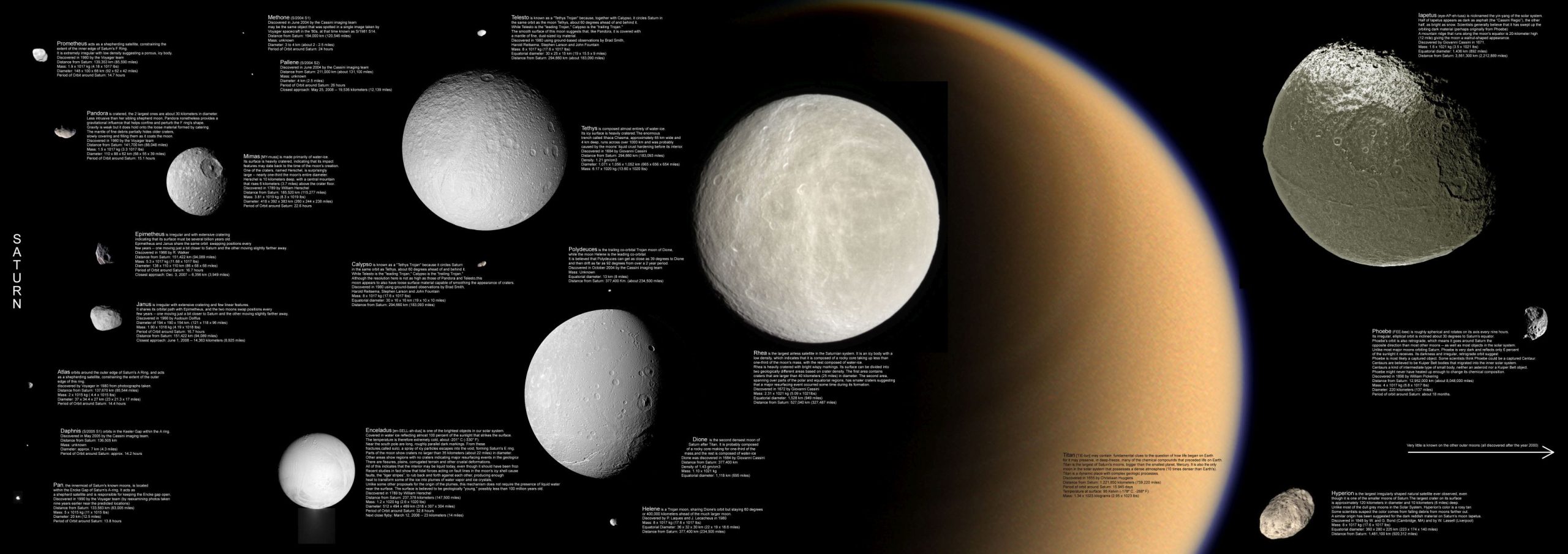
Given time, some technological innovation, and a serious (and long-term) commitment to energy and resources, there could be a new branch of humanity known as Cronians. And when people from Earth and other locations around the Solar System come to visit the Cronian moons, they might be treated to messages like this:
“Welcome to Kronos, your one-stop entryway to the Cronian System! We know the voyage was long, but we assure you, it will be worth it! After a brief acclimation period aboard the station, you will be able to take full advantage of our many worlds and our many, many amenities!
“For those destined for Titan, prepare for a wonderful time ornigliding in the yellow skies above Xanadu Terra. Or perhaps you would prefer a leisurely sail across Kraken Mare and the Northern Great Lakes. Or maybe a tour of the Adiri region, where you will witness the famous Titan dunes.
“But you absolutely must book a geo-tour to see the moon’s two most prominent features. These would be Titan’s largest mountain range and deepest chasm – Doom Mons and Sotra Patera! All the while, treat yourself to five-star dining and accommodations in Huygens City!
“Those of you headed to Enceladus are in for some real treats! Our guided crawler tours visit all the points of interest in the southern polar region: the Tiger Stripes, the Great Blocks, and the famous, majestic Cassini Plumes!”
“If you haven’t booked your accommodations yet, don’t fret. We have many adventure packages to choose from, and you’re hardly limited to just one! Consider visiting the Ridgeback of Iapetus, the ‘Death Star’ crater of Mimas, the enormous Ithaca Chasma canyon system, the many craters of Dione, or try surfing the icy Pandora and Prometheus Rings.”
“We remind all passengers that bio screens are mandatory upon entry to Kronos and the receiving stations on every moon in the system as well. We recommend familiarizing yourself with their profiles, as radiation levels and gravitational forces vary from place to place.”
Saturn’s Largest Moons
Since prehistoric times, humans have observed Saturn in the night sky and recognized it as part of the Solar System. In western astronomical traditions, the name Saturn was the Latin name for Kronos, the Greek god of agriculture and wealth. In Roman mythology, Saturn was the leader of the Titans and the father of the Olympians, including the father of Jupiter (Zeus in the Greek pantheon).
However, it was not until the 17th century that astronomers began to observe Saturn’s rings and system of moons. This included Christiaan Huygens, who discovered Saturn’s rings and largest moon (Titan) in 1655, followed by Giovanni Domenico Cassini, who discovered Rhea, Iapetus, Tethys, and Dione a few years later (all named after Titans in the Greek pantheon).

Between the late 18th and 19th centuries, William Herschel, William Henry Pickering, and several other astronomers discovered the remaining larger satellites, including Mimas and Enceladus. As of the early 21st century, 82 moons have been confirmed around Saturn, 53 of which have been formally named.
In keeping with Greco-Roman naming conventions, the moons were all named after the brothers and sisters of Saturn. By the 20th century, the names of Titans were exhausted, and subsequently-discovered satellites were named after gods and giants from Greco-Roman, Inuit, Gallic, and Norse mythology.
Saturn and its moons were visited by multiple robotic spacecraft, which included flybys by the Pioneer 11 (1979) and Voyager 1 and 2 (1980 and 1981) probes. They were also studied between 2004 and 2017 by the Cassini-Huygens mission. These missions revealed a great deal about the Saturn system and raised many questions about its potential habitability.
As noted, the largest of the Cronian moons is Titan, which measures about 1600 mi (2575 km) in radius (1.480 the size of the Moon) and weighs about 1.48×10²³ tons (1.3452×1023 kg) – 1.829 times as massive as the Moon. Between its mass and density, the gravity on Titan is roughly 13.8% that of Earth’s (0.138 g), which is slightly lower than the Moon’s (0.165 g).
Titan is believed to be composed of water ice (and volatiles like ammonia) and rocky material, in equal measure based on its bulk density. This is differentiated between an icy surface, a liquid water interior, a layer of ice at the core-mantle boundary, and a core of hydrated silicate material. Tidal flexing caused by Saturn’s gravity causes action in the core, which leads to water and ammonia erupting through the surface ice (cryovolcanism).
Prominent examples include the Doom Mons mountain chain and the Sotera Facula chasm system, located next to each other. At 4,757 ft (1,450 m), Doom Mons is Titan’s highest surface feature and one of the highest in the Solar System. Sotera Facula, meanwhile, is a caldera measuring 19 mi (30 km) across and 1.1 mi (1.7 km) deep, making it the deepest pit on Titan.
As noted, Titan also has several liquid methane lakes, resulting from the moon’s “methane cycle” (similar to Earth’s water cycle). The equatorial regions are covered in dark material, which scientists theorize are silica sands and organic hydrocarbon molecules. The Cassini mission revealed extensive dune-like features in this region that measure less than a mile wide and tens of miles long.
Unlike Saturn’s other moons, Titan is not an airless body. Its atmosphere is incredibly dense, averaging 146.7 kPa in pressure (1.45 times that of Earth), and is composed of nitrogen gas (95%), methane (~5%), and trace amounts of hydrogen gas and other hydrocarbons. Because of its distance from the Sun and its thick atmosphere, the average surface temperature is -291.1 °F (−179.5 °C).

Rhea measures 474.6 mi (764 km) in radius and has a mass of 5.07×1018 tons (2.3×1021 kg). The body is composed predominantly of ice, and the surface gravity is just 2.7% that of Earth’s (0.0269 g). Like many of Saturn’s moons, Rhea has a heavily cratered surface and some large fractures on its opposite side that are divided into two major sections.
The first section is covered in bright craters larger than 25 mi (40 km) in diameter, while the second is covered in smaller, younger craters. The difference between these features is indicative of a major resurfacing event at some time in Rhea’s past. The largest of Rhea’s impact basins are the Tirawa and Inktomi (“The Splat”) craters, which measure 220 mi (360 km) and 29.3 mi (47.2 km) across, respectively.
Iapetus is Saturn’s third-largest moon, measuring 456 mi (734.5 km) in mean radius and weighing in at 39.68×1017 tons (18×1020 kg). Iapetus is often referred to as the “yin and yang” of Saturn’s moons because of the color difference and composition between its leading and trailing hemisphere – i.e., the former is darker and reddish while the latter is brighter.
This difference is due to the presence of carbon-rich “tholins” within the leading hemisphere’s icy crust. These are organic molecules (such as methane) that have been exposed to radiation, causing them to darken over time and adopt their characteristic reddish hue.
Dione is the largest of Saturn’s inner moons and its fourth-largest overall, with a mean radius of 348.8 mi (561.4 km) and a mass of 2.4×1018 tons (11×1020 kg). The majority of Dione’s surface consists of heavily cratered old terrain – some measuring up to 155 mi (250 km) in diameter – but there is also an extensive network of features that indicate possible global tectonic activity in the past.
Enceladus has a mean diameter of 156.5 mi (252 km), a mass of 2.4×1017 tons (1.1×1020 kg), and is spherical in shape. Though it is one of Saturn’s smallest spherical moons, Enceladus is famous for being one of the few geologically active satellites in the Solar System. This is made evident by its “Tiger Stripes,” a series of continuous, ridged, and semi-parallel faults located around the moon’s southern polar region.
Another feature that indicates activity in the moon’s interior is the large geysers observed by Cassini in the southern polar region. These plumes are believed to result from geothermal processes that release heat (which maintains an ocean in the interior) and lead to the plumes of water, ice, gas, and dust observed on the surface. It is further speculated that this ocean could support life based on the presence of liquid water, heat, and organic molecules.
Mimas is the smallest and least massive of Saturn’s moons, which led to its slightly oblong shape. This moon has picked up the moniker of Saturn’s “Death Star moon” because its largest feature – the Herschel Crater – resembles the massive laser array on the Death Star from the Star Wars universe.
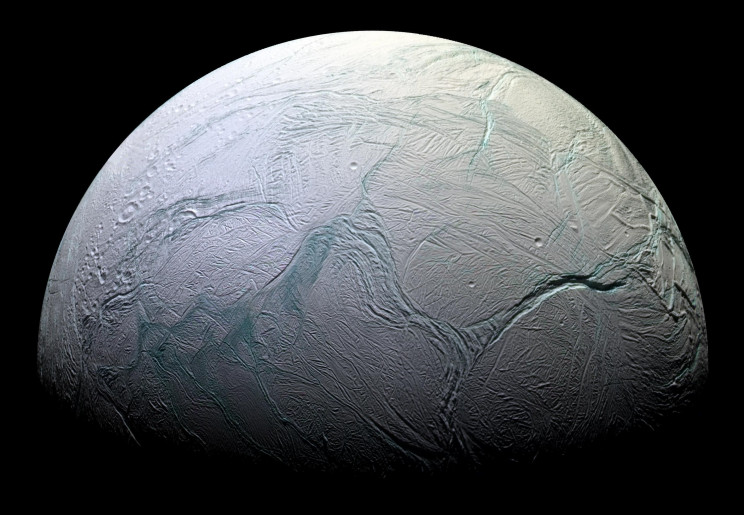
This crater measures 88 mi (140 km) in diameter, and the impact that caused it is believed to have created fractures on the moon’s opposite side. The many craters that dot its surface make Mimas one of the most pockmarked bodies in the Solar System.
Resources & Amenities
In his seminal book, Entering Space: Building a Spacefaring Civilization, Robert Zubrin described how Saturn and its system of moons could one day become “The Persian Gulf of the Solar System.” In addition to its low-radiation environment (compared to Jupiter), he also noted how Saturn is far richer in terms of Helium-3. This could power the future “fusion economy,” he claimed:
“Today, the Earth’s economy thirsts for oil, which is transported over oceans from the Persian Gulf and Alaska’s North Slope by fleets of oil-powered tankers. In the future, the inhabitants of the inner solar system will have the fuel for their fusion reactors delivered from the outer worlds by fleets of spacecraft driven by the same thermonuclear power source.”
According to Zubrin, winged vehicles that could enter the planet’s atmosphere – “Nuclear Indigenous Fueled Transatmospheric vehicles” (NIFTs) – could harvest Helium-3 from Saturn’s atmosphere: “After sortieing from its base on one of the planet’s moons, a NIFT would either cruise the atmosphere of a gas giant, separating out the He-3 or rendezvous in the atmosphere with an aerostat station that had already produced a shipment.”
Saturn also has a massive ring system predominantly composed of water ice with smaller amounts of rocky material and organic molecules (like tholins). Like Jupiter, it also has countless smaller objects and asteroids that follow its orbital path. These are believed to be rich in carbon, silicates, minerals, and organic molecules, with water ice in their interiors.
The Cronian system is also incredibly rich in volatiles, such as water, ammonia, and methane. These resources would facilitate the creation of local settlements and could also be exported to assist colonization efforts in the inner Solar System. For example, ammonia and methane (super greenhouse gases) would be vital to terraforming efforts on Mars.
Hydrogen gas could also be used to convert Venus’ atmosphere, while iceteroids could be directed at Venus’ surface to speed up its rotation. The abundance of methane could also be used as a fuel source, which would be non-combustible in Titan’s atmosphere due to the absence of oxygen (hence preventing it from catching on fire). Lastly, the massive supply of organic molecules could be used to create fertilizers for local and off-world use.
Hazards & Challenges
First and foremost, there’s the distance between Earth and Saturn. During an opposition, when Saturn and Earth are closest to each other, Saturn is approximately 746 million miles (1.2 billion kilometers) from Earth, or eight times the distance between the Earth and the Sun – or 8 Astronomical Units (AU).
When Saturn is in conjunction, or at their most distant, they are roughly one billion miles (1.7 billion km) apart, or 11 AU. However, Earth and Saturn are in opposition almost once a year, presenting more favorable launch windows than Mars – which occur every 26 months.
Still, using conventional methods, which include solid rocket boosters and gravity-assist maneuvers, it takes robotic missions three to six years to reach Saturn. The fastest was the Voyager 1 probe, which launched on September 5th, 1977, achieved a maximum velocity of about 38,214 mph (61,500 km/h), and reached the Saturn system by November 12th, 1980 (1164 days).
In contrast, the fastest crewed mission ever was Apollo 10, which achieved a maximum velocity of 24,791 mph (39,897 km/h). At this speed, a crewed one-way journey to Saturn would take about 30,090 days. Clearly, for missions to make the journey in a reasonable amount of time, more advanced propulsion technology is needed.
A promising method currently being investigated by multiple space agencies is nuclear-thermal and nuclear-electric propulsion (NTP/NEP). The former consists of a nuclear reactor that heats hydrogen propellant, with the resulting reaction mass being channeled through nozzles to create thrust. The latter relies on a nuclear reactor that generates electricity to power an ion engine.
According to NASA research, a mission equipped with a nuclear engine could reach Mars in about 100 days. Adjusted for Saturn, the same type of mission would still take about 1082 days (almost three years), which is still not economical. A more recent concept, the Vasimr VX-200SS plasma rocket, could reportedly make the journey to Mars in about 30 days, cutting the transit time to Saturn down to one year.
Compared to Jupiter, the radiation environment around Saturn is relatively mild. For instance, Jupiter’s moons of Io, Europa, and Ganymede are all subject to radiation that would be fatal (or at least very hazardous) to human health in a short time. This is a result of Jupiter’s powerful magnetic field, which has a strength of around 4.28 gauss (428 microteslas).
In contrast, Saturn’s radiation belts are significantly weaker, with an equatorial field strength of around 0.2 Gauss (20 MicroTesla). Whereas Jupiter’s field extends 1.864 million mi (3 million km) from the planet’s center, Saturn’s extends to a distance of 224,936 mi (139,000 km). This encompasses the orbits of Mimas and Enceladus, while Dione, Rhea, Titan, and Iapetus orbit beyond it.
Alas, there is still the issue of the low-g environments, none of which are anywhere close to Earth’s gravity. As NASA’s Twins Study demonstrated, the long-term effects of exposure to microgravity include muscle and bone density loss and impacts on cardiovascular health, organ function, eyesight, and even changes in gene expression.
While the effects of long-term exposure to low-g are not yet well understood, it’s a foregone conclusion that they will be similar. The potential impact on procreation is even less understood, but the risks are clear. The only foreseeable solution is to ensure that inhabitants on the Cronian moons stick to a robust regimen of exercise, healthy eating, regular medical check-ups, and possible biomedical treatments.
Another option is to create rotating space stations in orbit of major settlements that residents will periodically visit to spend time acclimating to Earth-normal gravity. This may need to be mandatory for pregnant and nursing women so that their children can develop and mature in an Earth-like gravitational environment.
Regular visits throughout an inhabitant’s lifetime could ensure that they remain healthy over the long term while also ensuring that a human presence around Saturn is sustainable.
Solutions For Living
Compared to every other satellite in the Solar System, Titan’s dense atmosphere presents several advantages for human settlement. For starters, surface habitats wouldn’t be subject to a massive pressure differential between their interiors and the exterior. As such, a breach in a habitat’s wall would not lead to explosive decompression but rather a relatively slow leak from the external atmosphere into the interior.
The dense atmosphere would also help protect against solar and cosmic radiation. This would allow long-duration operations on the surface that wouldn’t require too much additional shielding. Still, pressurized suits would always be needed for outdoor activities, and habitats would need to be heated and insulated against the outside cold.
The abundance of methane and other hydrocarbons on the surface could be harvested and burned by furnaces to provide for these heating needs. Similarly, locally-harvested He-3 could also be used as a fuel source to power hydrogen reactors on the surface. In all cases, these reactors would need to be sequestered to prevent methane or hydrogen gas from mixing with a habitat’s air supply (where it would be flammable!)
Carbon could be harvested from local asteroids to mass-produce graphene ribbon, which has the tensile strength to support a Space Elevator here on Earth. On Titan, where the gravity is significantly lower, graphene ribbons would be under much less stress and could accommodate heavier payloads. One or more of these elevators would facilitate trips to and from the surface and a robust export economy involving water ice, volatiles, nitrogen, and organic-molecule fertilizers.
On Titan’s airless moons, Rhea, Iapetus, Dione, Enceladus, and Mimas, airtight habitats could be constructed on the surface using local regolith and metals. As with Jupiter’s icy moons, settlements could be built within craters, with a dome enclosing the habitat and a layer of regolith used to create an insulating layer beneath.
Local ice could then be chemically disassociated to create oxygen gas and combined with nitrogen gas (N2) from Titan to create breathable atmospheres for the habitats. Nitrogen could also be fashioned locally from ammonia, which is composed predominantly of nitrogen and hydrogen.
Whereas the N2 would provide a buffer gas for the habitat’s internal atmosphere, the hydrogen could be fashioned into hydrogen gas (H2) to make propellant and fuel for fusion reactors. Organic molecules, which Saturn’s other moons also have in abundance, could be added to regolith (along with locally-harvested water) to create soil for agricultural operations.
Over time, the introduction of plants and animals could also lead to a bioregenerative life support system capable of replenishing itself, producing oxygen and food, and scrubbing carbon from the air. Creating a natural biome would also mean that these settlements would be sustainable over time and would not require regular supply shipments.
Let’s Get Ethical (again!)
Similar to the idea of building settlements on Mars and the Jovian moons, the possibility that some of Saturn’s moons could support life raises serious ethical questions. For example, several Cronian moons are believed to have interior oceans that could support life, especially Enceladus. Titan is also a candidate and could even have lifeforms on its surface in the form of methanogenic sea creatures.
Bases on these moons would be able to conduct lucrative astrobiological research that could answer enduring questions about how life began in our Solar System. But the presence of these bases, the nature of their investigations, and settlement efforts could present serious dangers to the local lifeforms and their life cycle.
Therefore, any human presence would need to be accompanied by stringent planetary protections that would allow for human settlements while still ensuring that local biospheres are not disrupted. One possibility would be to establish “nature preserves” where humans are not allowed to venture, and all commercial activity is prohibited.
In particular, it may be necessary to establish quarantine zones around Enceladus’ southern plumes, Titan’s great methane lakes, and any other sensitive environments. In particular, unless scientific researchers can ensure that their robotic explorers are completely sterile, the exploration of the interior oceans or any potentially-inhabited environment should remain strictly off-limits.
But of course, this does not mean that humans can’t coexist on these worlds with whatever lifeforms they may already have. As long as future settlers abide by environmental laws and respect the local ecology, a thriving culture (and economy) could be created in the Cronian system. Its many moons could accommodate surface habitats where thousands (or millions) of people live and work and conduct some of the most lucrative scientific research ever imagined.
With the right planetary protections, this research could finally reveal how life began in the Solar System billions of years ago. Furthermore, it could shed light on how life was distributed, whether it began on Earth and spread to other bodies or was introduced from space! Future scientists might also find that life emerged independently in the Cronian moons and is unrelated to life on Earth.
Saturn’s moons could also become a major source of resources for the rest of the Solar System. As Zubrin indicates, the right infrastructure could mean that the Cronian System could someday become the “Persian Gulf” of the Solar System. The extraction of He-3 and the creation of liquid hydrogen fuel would make it a central part of an interplanetary “fusion economy.”
However, the Cronian system could also provide other planets and moons with all the major resources they require to sustain their populations – such as water, ammonia, methane, and fertilizers. With the right kind of propulsion technology, these moons could be regularly visited by humans from the inner Solar System, the Frost Line, or Jupiter’s moons.
A tourist economy would follow, with all the necessary accommodations (hotels, adventure tours, cultural centers, casinos, etc.). Fuel depots and maintenance platforms located across the Cronian System would facilitate the coming and going of these passenger ships. They could even enable missions that explore the outer Solar System even further.
Spacecraft launching from Saturn’s moons could visit Uranus and Neptune and explore their systems of moons, as well Pluto and Charon and other bodies in the Kuiper Belt. Perhaps they might even service missions to other star systems someday!
While the challenge of sending humans to Saturn to colonize its moons is still well beyond us, there’s little doubt that it will be within our grasp someday – perhaps sooner than we think! With time, energy, resources, and plenty of grit, there could be a new branch of humanity known as “Cronians!”
The rest of humanity would be very interested in visiting them and their worlds as often as they could. When it came time to head home, they could be listening to messages of farewell like this:
“From all of us here in the Cronian system, we bid you adieu and hope you will return to see us again someday. In the meantime, we hope you enjoy all of the amenities of Kronos Station as you undergo ‘gravity therapy.’ Please remember to undergo a comprehensive medical before you leave and a reminder to have your medical certification ready before boarding your transport.
“We’d also like to issue a final reminder that customs will need to ensure that you are not transporting any domestic flora or fauna. The transport of such items, intentional or otherwise, is strictly forbidden. Let’s keep Saturn’s ecosystems secure and prevent the spread of invasive species and germs!
“All those destined for the Uranian and Neptunian research stations are advised to undergo medicals upon arrival and departure. We thank you for the lucrative work you’re doing to expand humanity’s horizons, explore the great unknown, and ensure that future generations can settle even farther from Earth someday!
“After seeing all that we have to offer, we’re sure you’ll agree: Saturn is not just the Solar System’s ‘fuel depot.’ It’s also the next great frontier and one of the greatest places to live, work, and play!”

